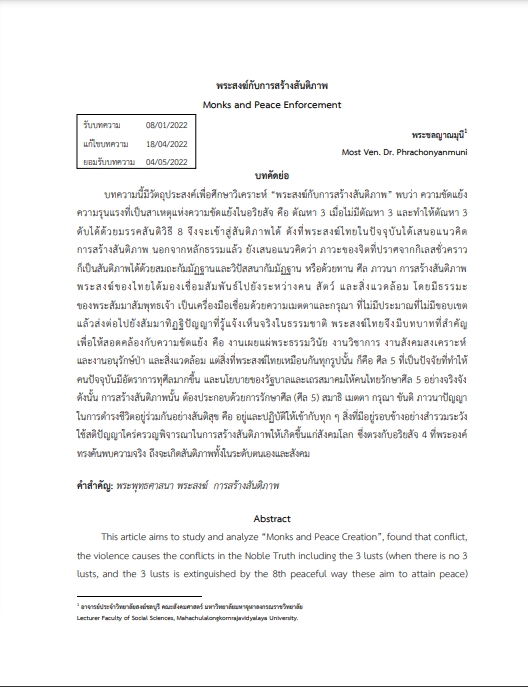Monks and Peace Enforcement
Keywords:
Buddhism, Monks, Peace EnforcementAbstract
This article aims to study and analyze “Monks and Peace Creation”, found that conflict, the violence causes the conflicts in the Noble Truth including the 3 lusts (when there is no 3 lusts, and the 3 lusts is extinguished by the 8th peaceful way these aim to attain peace) As the present,Thai monks have proposed the concept of creating peace regardless of dharma principles. Also, they proposed the idea that the state of mind that is temporarily devoid of defilements can be peaceable either through samatha and introspection, or through alms, precepts, and prayers. To create peace, Thai monks look at the connection between people, animals, and the environment by using the Dharma of the Lord Buddha as a tool to connect with compassion and please with no boundaries and then pass it onto the enlightened wisdom of nature. Therefore, Thai monks play an important role in accordance with the conflict, namely, propagation of the Dharma and Disciplines academic affairs, social affairs,
and forest and environment conservation. However, what all Thai monks have in common is
the 5 precepts that are the factor that Thai people nowadays have a higher rate of immorality.
Thus, the policy of the government and the Sangha Council delude for Thai people to seriously observe their 5 precepts. Accordingly, peace enforcement much include observing
the precepts (the 5 precepts), meditation, mercy, compassion, patience, and prayer seriously
in order to stay in way of li together peacefully to live and practice in consistent with everything that surrounds him carefully, use their intellect to consider and build peace enforcement to the world. This corresponds to the 4 Noble Truths that Lord Buddha discovered the truth to achieve peace both at the individual and society level.
References
ธรรมเกียรติ กันอริ. (2542). พุทธวิบัติ. กรุงเทพฯ: อมรินทร์พริ้นติ้งแอนด์พับลิชชิ่ง.
พระครูประโชติรัตนากร รตนโชโต (น้อยศิริสุข). (2558). สันติภาพเชิงพุทธ: แนวคิดและบทบาทการสร้างสันติภาพของพระสงฆ์ไทย. วิทยานิพนธ์พุทธศาสตรดุษฎีบัณฑิต สาขาวิชาพระพุทธศาสนา บัณฑิตวิทยาลัย มหาวิทยาลัยมหาจุฬาลงกรณราชวิทยาลัย.
พระธรรมปิฎก (ป.อ. ปยุตฺโต). (2542). มองสันติภาพโลกผ่านภูมิหลังอารยธรรมโลกาภิวัตน์. กรุงเทพฯ: กองทุนรักษ์ธรรม.
พระพรหมคุณาภรณ์ (ป.อ. ปยุตฺโต) (2540). การศึกษาเพื่อสันติภาพ (พิมพ์ครั้งที่ 6). กรุงเทพฯ: สหธรรมิก.
พระพรหมคุณาภรณ์ (ป.อ. ปยุตฺโต). (2542). มองสันติภาพโลก. กรุงเทพฯ: ธรรมสาร.
พระไพศาล วิสาโล. (2553). ขอคืนพื้นที่ธรรม. กรุงเทพฯ: มติชน.
พุทธทาส. (2536). สันติภาพของโลก. กรุงเทพฯ: ธรรมสภา.
พุทธทาส อินฺทปญฺโญ. (2549). ธรรมสำหรับคนเกลียดวัด. กรุงเทพฯ: ธรรมสภา.
อรปรียา วสุมหันต์. (2553). พุทธวิธีจัดการความขัดแย้งในทัศนะของพระไพศาล วิสาโล. วิทยานิพนธ์พุทธศาสตรมหาบัณฑิต สาขาวิชาพระพุทธศาสนา บัณฑิตวิทยาลัย มหาวิทยาลัยจุฬาลงกรณราชวิทยาลัย.

Downloads
Published
How to Cite
Issue
Section
License
Copyright (c) 2022 Journal of Humanities and Social Sciences Nakhon Pathom Rajabhat University

This work is licensed under a Creative Commons Attribution-NonCommercial-NoDerivatives 4.0 International License.
Journal of Humanities and Social Sciences Nakhon Pathom Rajabhat University





